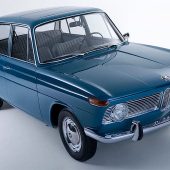Tatsuo Hasegawa, development leader of the first generation Toyota Corolla, first came up with the concrete concept for the Corolla in the latter half of 1962. Based on his experience with the Toyota Publica (1961-1978), considered Toyota’s starting point in family cars, Hasegawa proposed an entirely new vehicle plan. The Toyota Publica was a car that pursued practical utility and economy and focused on achieving a retail price of 360,000 Japanese Yen. At that time the average monthly salary in Japan was 26,000 Yen. However, with those simplified specifications and features, vehicle sales remained stagnant without gaining much support from the general public. The purchase of a car was one of the dreams of the general public, and more than mere utility, the public wanted a car in which they could be proud — a car that portrayed a sense of luxury. Hasegawa reflected on that time, stating: “Since that time, the market has demanded attractive vehicles, vehicles that don’t seem inferior when compared to others and vehicles that appear even somewhat luxurious. If we consider these types of market needs, the Publica probably looked somewhat cheap.”
“Existing parts can’t be used to meet the demands of the upcoming era.” With that in mind, a concept was launched that called for a newly developed vehicle, including the engine and suspension. A full-scale development was started in 1963. However, the go-ahead for this plan was not easily obtained. The development of a new vehicle required a huge expenditure amounting to several billion yen. In addition, Toyota was experiencing rapid growth; each time a new vehicle was developed, equipment investments of several tens of billions of yen were made and new plants were constructed. For that reason alone, failures in new vehicle developments were not allowed. At first, approval was given for only the development of a new engine. Eventually, a new plant costing 30 billion yen was constructed for this Corolla alone.
The new engine was planned to have a displacement of 1.0-liter engine and a maximum output of 45hp/5500rpm. While it was known that the OHC (overhead cam) was an effective measure in creating a high performance engine, the team lacked experience in design and abandoned the idea. Instead, an OHV (overhead valve) was selected. As engine displacement in competitor’s family cars were starting to reach 1.0-litre, the design objective was quickly changed to 1.1-litre engine. The new car included numerous new developments and technologies. One troubling point was that there were very few previous examples of the compact, lightweight MacPherson strut based front suspension adopted for the Japanese vehicle. One incident during testing — the first prototype vehicle could only travel a mere 500 meters — symbolizes how difficult new developments can be. Prototypes and tests were repeated time and time again. After two-and-a-half years of development work, the suspension configuration was completed and the team was finally able to see the light at the end of the tunnel.
About one year before the vehicle was released, overseas expansion was considered, and a plan for export to the United States was developed. According to the Design Plan Policy — document put together by Hasegawa that summarized the Corolla development concepts, “In the future, the Corolla will compete both in Japan and overseas with European made cars in the same class, and the superiority of the Corolla over the competition will be ensured through ‘performance’ and ‘economic efficiency.’” From its early stages, developments were focused on export, and it is evident that the team targeted the Corolla to open up new markets and be competitive overseas.
When the Corolla was first released, only a 2-door sedan was available. From there, a 4-door sedan and van were added to the lineup for a total of three body types for this first generation. At first Corolla was equipped with the K engine with a displacement of 1.1-liter to provide a 0.1-liter advantage over the numerous 1.0-liter engines in its class. The engine generated a maximum output of 60hp/6000rpm and a maximum torque of 8.5kg-m/3800rpm. Numerous revolutionary technologies were adopted, such as a 5-bearing crankshaft that can endure high speeds and a high camshaft system to achieve high performance. In addition, in the latter half of the model period, the 3K engine was adopted with engine displacement expanded to 1.2-liter. This engine generated a maximum output of 68hp/6000rpm and a maximum torque of 9.5kg-m/3500rpm for improved acceleration performance in medium and high speed ranges.
Sports car technology was adopted for the transmission, and the vehicle was equipped with a 4-speed fully-synchronized manual transmission with a floor type gear change lever. This marked the first time that this type of transmission was adopted in a Japanese vehicle, and a sporty, direct shifting feel was achieved. In addition, Japan’s first floor-mounted 2-speed automatic transmission and a steering column-mounted 4-speed manual transmission, already familiar in other vehicles, were made available.
For the front suspension, a MacPherson strut type suspension was adopted for the first time in Japan. To ensure a quiet interior, a semi-floating type rear suspension was adopted that reduced the squeaking noise from the leaf springs. When the Corolla was first released, drum brakes were adopted for both the front and rear. Midway through the model period, for the first time on a family car, front disc brakes were adopted on some of the models. In addition, safety countermeasures were progressively enhanced during the model period, including pull-type recessed outside door handles without projections and 2-point and 3-point seatbelts. Original safety designs were also incorporated, such as 2-speed wipers, an impact absorption steering wheel and column, headrests and parking brake warning lights. Separate bucket type seats that materialize the “sporty image” were adopted for the front seats. In addition to a front to back slide adjustment range of 120mm and a 16-step reclining mechanism, the seats could be fully reclined. Equipment found in higher grade vehicles but not in family cars, such as armrests, a console box, radio and heater, were also adopted to create a dramatically more comfortable interior.
Specifications Toyota Corolla 2-door sedan 1969
Engine
- type K-D
- water cooled, inline 4-cylinder OHV
- 1077cc
- petrol
Power
- 64 hp / 6400rpm
Transmission
- 4-speed manual
- RWD
Vehicle weight
- 730 kg
Overall length
- 3855 mm
Overall width
- 1485 mm
Overall height
- 1380 mm
Wheelbase
- 2285 mm










